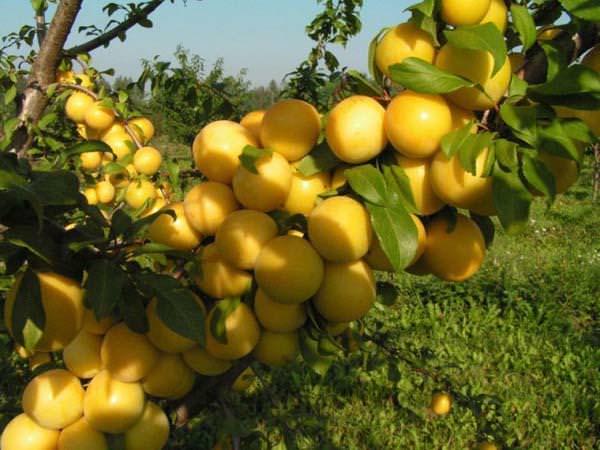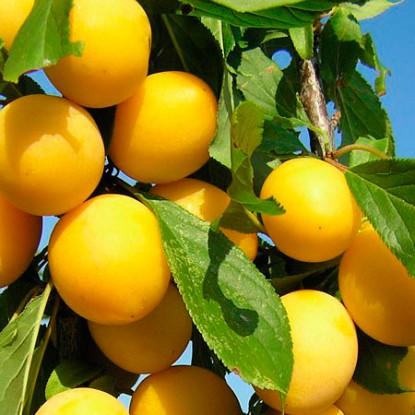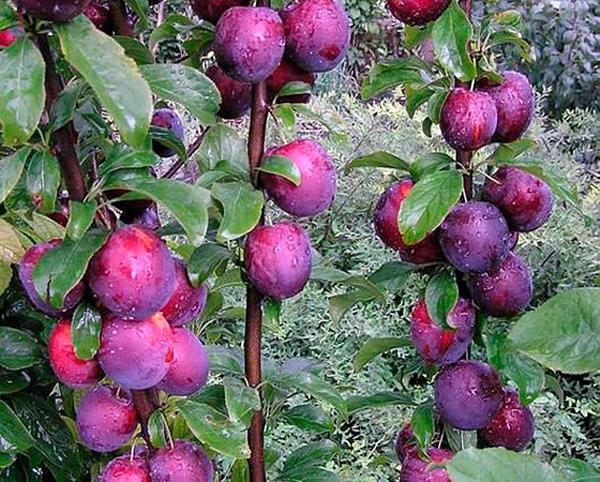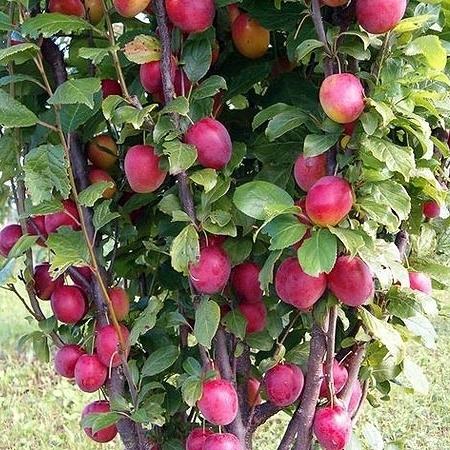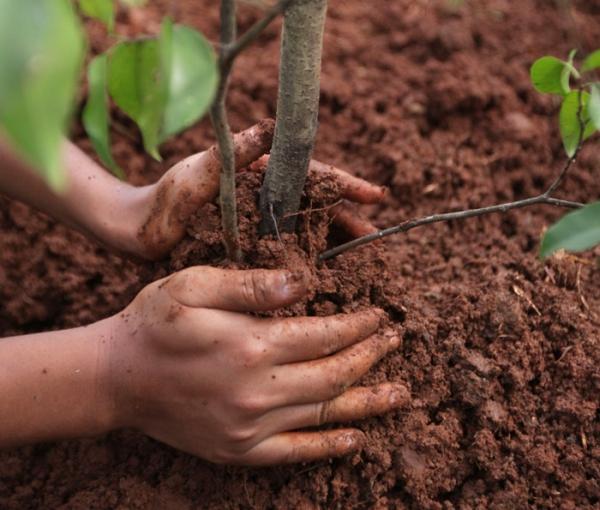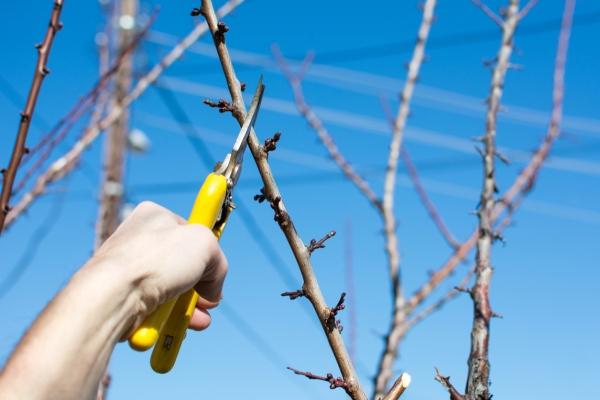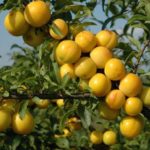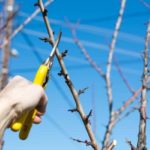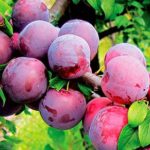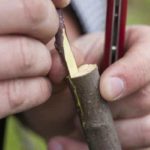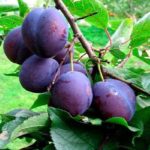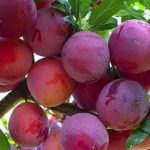Many have not heard of Columnar plums, but experienced summer residents have managed to appreciate the variety. The variety is compact in size and the trees produce a bountiful harvest. The main feature of the plum is the absence of lush branches and wide bushes. To properly grow a crop, you should familiarize yourself with all its features and a detailed description of the varieties.
- Description
- Plant varieties
- Imperial
- Blue Sweet
- Yellow
- Honey
- Mirabella
- Russian
- Ruby
- Commander
- Oscar Plus
- Angers
- Olenka
- Features of growing a tree
- Boarding time
- Selecting a location
- Planting principles
- How to care
- Pruning a plum tree
- Fertilize the columnar plum
- Watering
- Preparing the tree for winter
- Treating plants against diseases and pests
- Collection and storage
Description
Columnar plums are trees with a narrow but dense bush directed upward in a vertical direction. The plant is shaped like columns. Almost all branches take part in fruiting. There is practically no need to create a culture. The variety was bred artificially. The tree belongs to the rose family. The height does not exceed 2.5 meters. The color of the fruit is yellow, violet-purple, blue.
Plant varieties
Varieties of dwarf plums have different periods of ripening, differ in the color of the fruit, and the ability to self-pollinate. There are many varieties of this crop, all of them do not require painstaking care and are excellent for growing in the country.
Imperial
Imperial. The subspecies is famous for its large fruits weighing up to 55 grams, delicate, aromatic taste. The shape of the fruit is round, the top is compressed, with a wide base. The skin is dense, but this does not affect the taste. The tree grows up to 2 meters high and bears fruit by mid-late August. The variety is self-fertile, the fruits are pinkish-violet in color, but can also be red-brown in color. Negative traits include the need for abundant watering and the likelihood of pollen in the first year of life. If this happens, cut off the inflorescences, since an early harvest can deplete the young tree.
Blue Sweet
Blue Sweet. The fruits are large, reaching a weight of 75 grams. They are oval-shaped, flattened. The thick skin has a waxy coating. The tree grows 2 meters high. The taste is refreshing, sweet and sour. During the season you can collect up to 15 kg of plums from one tree. The pods ripen by August and need pollination. Varieties Blue Free and Stanley act as pollinators. The color of the fruit is purple, the flesh is slightly pinkish.
Among the disadvantages is the risk of the top of the tree splitting due to frost.Also, the variety can bloom in the first year of life.
Yellow
The yellow plum bears fruit earlier than other varieties. The harvest is harvested by the end of June. The fruits are large, round, yellow, with the smell of honey. They are eaten raw or canned. The plum pollinates itself, but with constant rains and diseases, nearby pollinators are required. The tree is large, growing up to 2.5 meters in height. The variety is resistant to frost and disease.
Honey
Honey plum produces golden yellow fruit, sweet taste, weighing up to 50 grams. The fruits ripen at the end of July. The variety does not self-pollinate. Vengerka and Renklod Karbysheva plums should be planted nearby. The plant tolerates severe frosts and is resistant to attacks by harmful insects and diseases.
Mirabella
This is one of the fastest ripening varieties of plums, which brings a lot of harvest. From one tree you can collect up to 15 kg of medium-sized fruits. Each of them weighs more than 40 grams, but this does not affect the taste or fruity aftertaste. The fruits are similar to apricots in appearance, only on one side they are covered with blush. The pulp has a dense structure and a pleasant, sweet taste. Fruiting occurs at the end of August. Ripe fruits do not fall from the tree for a long time. The variety is resistant to diseases and harmful beetles.
Russian
Russian plum belongs to the dwarf varieties, since the growth of these trees does not exceed 1.7 meters. The fruits grow small - up to 40 grams, ripen by mid-August. Plums are pollinated using cherry plums. The fruits are purple and sweet.
Ruby
Ruby plums grow red in color with a sweet and sour taste. The tree grows up to 2 meters high. The fruits should be collected in early September. Ruby is a large-fruited variety; one plum weighs 60 grams. The variety is self-fertile.Disadvantages include late fruit ripening.
Commander
The Commander plum variety differs from others in the reddish and purple color of its skin. The tree bears juicy, sweet, large fruits. The pulp is tender, yellow in color with a sweet taste. The fruit is used to make preparations for the winter or eaten fresh. The variety ripens in mid-July, earlier than other plums. The tree grows up to 2 meters high.
Oscar Plus
The Columnar plum variety Oscar Plus is famous for its round fruits, slightly pressed towards the top. The plant ripens by September and the fruit is brown or purple. The tree exhibits winter hardiness and resists diseases and beetle attacks.
Angers
Angers is a mid-season variety of Columnar plum. The fruits are purple-crimson, weighing 40 grams. They have a pleasant fig taste. Among the advantages are the possibility of self-pollination and easy tolerance of cold weather.
Olenka
The plum variety Olenka produces fruits of a bright red hue and small sizes. The weight of one fruit is 25 grams. The variety is self-sterile, but if there is a Stanley or Blue Free nearby, there will be a lot of harvest. The tree withstands frosts, is resistant to the development of diseases and beetle attacks.
Features of growing a tree
Columnar plum does not require unique growing techniques. The variety is unpretentious in care; you need to look after it in the same way as your brothers. The main thing is to choose a good seedling, water the plant on time, and loosen the soil.
Boarding time
Planting of columnar plums should be carried out in the fall, if we are talking about the South. In northern latitudes and the Urals, postpone planting until spring, when the snow melts and there will be no night frosts.
Selecting a location
You need to plant the plum in a place where the sun shines strongly and there is no shadow. Culture loves good lighting. The variety should not be exposed to northern winds, and the planting site should be free of melt water. The desired groundwater level is 1.5 meters. If you ignore the above requirements, the rhizome will not form, the trunk will be damaged, and the plum will become sick.
Planting principles
Agrotechnical work must be carried out in accordance with the following stages.
- Dig a hole 30*40 cm, determine its length by the number of seedlings. There should be a distance of 50 meters between them.
- On industrial plantations, the width between rows should be 1-1.5 meters.
- Pour fertile substrate - compost - onto the bottom; 3-4 kg is shown per seedling. You cannot use mineral fertilizers when planting; the rhizome is delicate and can easily be damaged by chemicals.
- Place the planting material in the prepared hole, carefully straightening the root system. The neck should be 2.5-4 centimeters above ground level.
- Cover the trees with soil, lightly compacting the soil. Use root growth stimulants - Heteroauxin. A solution is prepared in the proportion of 1 g of product per 3 liters of water. Water the seedlings with the mixture immediately after planting and 2 weeks later.
When using root growth enhancers, it is important to strictly follow the instructions. Otherwise, the plant may get a chemical burn.
How to care
Care after planting the Columnar plum is almost no different from the standard one. To stimulate rooting, feed the seedlings with growth stimulants. Carry out sanitary pruning so that the plant produces a lot of harvest.
Pruning a plum tree
The formation of the crown is required for all fruit trees, so that only those branches that will bear berries grow, without unnecessary thickening. Pruning of Columnar plum is carried out in the spring, before the first buds swell. Since the tree is low-growing, the top should not be removed. Removal of dry, damaged or diseased branches is required.
Fertilize the columnar plum
In order for a plum to grow actively and produce a lot of harvest, it is necessary to fertilize it. Use urea, dilute 50 g in 10 liters of water. One plant needs 2 liters of solution. The first feeding is carried out during the active growing season, the second – 2 weeks after the first fertilization. Feed the soil for the third time 14 days after the previous one. Mullein infusion and saltpeter are widely used.
Watering
It is necessary to irrigate the plum regularly, paying attention to the moisture of the soil. Water the tree no more than once a month. If there is severe drought, pour water under the root 2-3 times weekly. Let the liquid stand so that it is not icy. Otherwise, the plant will drop its fruits.
Preparing the tree for winter
Young trees do not survive frosts well; trees must be prepared thoroughly before frost. Cover the trunk part with fallen leaves and straw, cover the lower part of the trunk with pine needles. This will help protect the tree from rodents. Cover the top with additional snow.
Treating plants against diseases and pests
Columnar plums are resistant to disease, but if the rhizome and branches are deformed, the tree may become diseased. Preventive treatment with copper sulfate, spraying with Bordeaux mixture or Topsin-M is required.
Collection and storage
Harvest time depends on the variety and the climate of the region. In the Urals and Siberia, plums ripen towards the end of summer or September.In southern latitudes, the harvest will be ripe by the end of June. Early varieties of fruits are harvested over several weeks, and late varieties are harvested immediately. The procedure should only be carried out in dry weather. If the variety is early ripening, remove fruits from the branches in several passes, since they ripen unevenly.
You need to store plums in a place with an air temperature of 0-2 degrees Celsius and a humidity of at least 85%. Store fruit in low trays with paper on the bottom or in wooden boxes. When transporting, try not to damage the wax coating. Plums that will not be stored should be eaten immediately or stored for the winter.
Unripe fruits should not be stored in the refrigerator, this will slow down the ripening process and worsen the taste. The fruits will keep intact for 3 weeks at a temperature of no more than 7 degrees Celsius.


